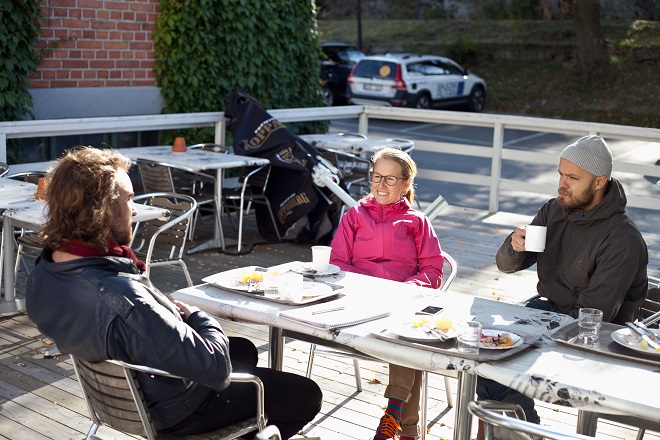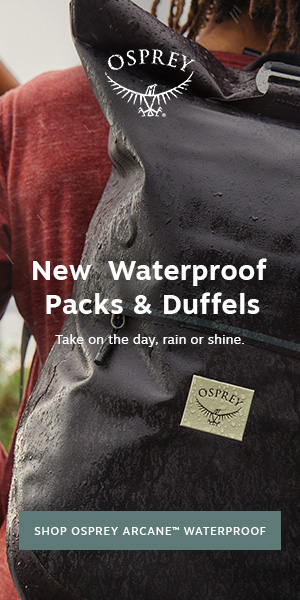Haglöfs HQ Visit
We’ve just entered a Swedish trucker’s cafeteria in Kallhäll, an industrial township 40 minutes out of Stockholm by train. Beefy drivers in caps are elbows deep into trays of the day’s specials, and I get the sense that saloon doors at the entrance here would be less out of place than us.

This is the “downtown” lunch option, according to our hosts, who work in the now chalet-white, warm interior of the former Electrolux factory warehouse around the corner. They are Henrik Björkman, Elin Hellemar and ‘Big Boss’ Viktor Wramdemark, the award-winning hardware team at Scandinavian brand Haglöfs, and they assure me the fish is good.

If you’re not Scandinavian, you may not have come across the Haglöfs name. For non-Nordics, it’s pronounced ‘hog-lerffs,’ and it’s perhaps the most respected outdoor brand in Sweden. Its backpacks and outdoor wear are a force in the market, its popularity stemming from the fact that it’s one of the most seasoned veterans in the field; so too, because it began, and sustained, as a family brand that never gave up its commitment to genuine, quality production.

I order the fish, and join the crew out on the rear deck. Henrik relaxes like a hip wharfie in beanie and sockless brogues; Viktor, a tall unit with a red mop of surfer’s hair; Elin, chirpy and upbeat, who tells me she rode into work today, hence her recreational attire (Haglöfs from head to toe). Dappled noon sun flits on our foreheads, and the air is the cleanest on earth.

“Soon, there will be no sun for six months,” says Henrik, who speaks in measures with a laid-back croak (no doubt from mild jet lag after flying back from Vietnam just hours earlier). “I actually went out in the jungle this time,” he says, “to the Mekong, in this gondola boat, with anacondas and stuff everywhere.”
“Its backpacks and outdoor wear are a force in the market, its popularity stemming from the fact that it’s one of the most seasoned veterans in the field; so too, because it began, and sustained, as a family brand that never gave up its commitment to genuine, quality production.”
He and Elin travel to the Haglöfs factory in Ho Chi Minh four times a year to research samples. “They’re so fast and skilled,” Henrik says. “One time we went out there, and sometimes it’s hard to explain things in words, or in pictures, and a colleague of ours was like ‘can I just borrow a sewing machine and show you?’ And he sat in the machine and just touched the foot pedal…and it was like: BHHRRRRMMM! They were ten times faster than our machines.”
While production takes place offshore, Elin and Henrik call the shots for all of Haglöfs’s hardware design, backpacks and bags included. “We do almost everything, from the first idea, to presenting that to the sales guys – that marketing side of it,” Elin says.

“It’s a big benefit,” adds Viktor, who oversees the company’s hardware and footwear sectors: “the designers need to look in the market; they need to follow the product all the way. Being the best ones to know the product, they know how to sell it.” “You give the love to these products,” adds Elin. “They’re our babies.”
With over 100 years of research, development and production to its name, Haglöfs is far from a newborn. In 1914, the story goes, founder Wiktor Haglöfs began sewing backpacks on his family’s farm outside Borlänge, a rural municipality four hours north of Stockholm. They were an instant hit with local workers and school children; Haglöfs grew into a thriving enterprise: new employees, a larger factory, and with the advent of the Second World War, they became key suppliers to the Swedish military.

Over the decades, Wiktor refined his packs with ingenuity, never yielding to anything but superior quality and the finest, most durable construction. In the ‘70s, his sons Rolf and Hans took the reigns, sold the company off, and set up a new hardware factory in Borlänge called SACCI. After a series of ownership changes and a fresh technical direction, the company landed in 2010 in the hands of Japanese multi-national, ASICS.

Encouragingly, Wiktor Haglöfs’s 100-year-old ethic still thrives beneath the ASICS umbrella: that unerring quality, and free creative license. Essentially, ASICS bought Haglöfs because they love the brand.
“Wiktor Haglöfs’s 100-year-old ethic still thrives beneath the ASICS umbrella: that unerring quality, and free creative license.”
“When it comes to product, and aesthetics, we’re free to do what we want,” says Henrik. “We pretty much know what we’re doing in the backpack area,” adds Elin, “I would say they come to us to ask us about backpacks.”

Rare it is these days for a company in any industry to survive 100 years. In 2014, Haglöfs did, and celebrated in style. To commemorate the moment, Elin and Henrik guided the creation of RYGGSÄCK N:O 1, a limited edition pack that arched back to the company’s roots.

As well as being constructed from 100% Swedish materials (except for the thread, I’m told, which came from Germany, the one thing Sweden doesn’t produce), the ‘Number 1’ handed the company an awesome ‘full-circle’ story: inspired by Wiktor Haglöfs’s early century designs, the limited run of 1000 units were produced by his sons in their SACCI factory, a short stroll from the very same wooden shack where their father founded the family’s legacy a century earlier. It was a fitting capstone to a century in the game.
“For me, it was the most fun product we’d ever done,” says Henrik, “It was really tough: the first time we did something like this; the first project we all really shared.”
With two and a half years’ lead-up, it was also the longest. “At first, we had a whole room full of ‘this is what it shouldn’t look like,” he laughs.

The project was proof, too, of the founding family’s lasting influence on the brand’s modern incarnation. “When we contacted them (the Haglöfs brothers), Hans, of course, just lit up; he went into deep, deep hiding places to pick out old moulds and stuff from the ‘30s and ‘40s. They’ve kept everything.”
One of the greatest values of Haglöfs is its history. “In the more present past, we haven’t been that clear about that. The 100 years ticking past was a reminder that we ought to be communicating more about it,” adds Viktor.
“One of the greatest values of Haglöfs is its history.”
The Number 1 accompanied a suite of fresh designs launched to coincide with the Haglöfs centenary. Fall/winter 2014 also saw the release of 19FOURTEEN – a collection of packs, bags, clothing and shoes, driven by a demanding, and versatile, fresh urban look.
“For Haglöfs, it has almost been a little bit ‘forbidden’ before, to make a casual collection: ‘we’re outdoor…we should be outdoor,’” says Viktor.

The new inspiration? Themselves. “It was something new, and something we all wanted to have, because we use these products every day,” adds Elin. “Today, people want to buy one piece of gear and use it for all different activities,” says Henrik. “The whole outdoor business is turning in that direction. People want to be able to use the same backpack for back and forth to work, and be able to bike commute, or go on a mountain bike trip after work.”
The new line marked an evolution in the company’s aesthetic, so too, a sign of things to come. “What we did has peeled off to the rest of the collection. It’s broadened, and opened our eyes.” The 2017 winter range, already on the team’s radar, will presumably pick up from where 19FOURTEEN left off.

Viktor leaves us after lunch – there’s a big sales conference in the showroom back at HQ – while Elin and Henrik chaperone us a short stroll away to nearby Lake Mälaren, the shimmering waters of which Haglöfs employees are free to, and frequently do, swim in during their summertime lunchbreaks. In winter, they ski. Elin points out the mini slope by the tree line where they test out products. To maximize sun exposure in the colder months, lunchbreaks are flexible. A personal trainer comes in to run fitness classes twice a week.

“It’s probably the best workplace you can think of,” says Elin. Henrik nods. “When I started here, it felt like I stopped working.”
“Everybody here is into outdoor activities, and the activities bond people together. The job becomes fun,” says Elin. “This is the first time that I ever met people with the same values…about life.”
“It sounds like, er…we’re making this up,” laughs Henrik.
But it’s clear that they’re not. Back at HQ, workers are finishing up lunch in a communal dining room that looks like the pitch-roofed social quarters of a contemporary ski chalet. Good vibes and productivity flow through the place.

On the final leg, Henrik and Elin reveal their workspace, a cosy nook amidst the labyrinthine split-levels of the Haglöfs chalet cubby house. It’s surprisingly neat, the trademark Swedish blend of style and functionality to induce maximum creativity. There’s a bunch of paper prototypes on a sorting bench, one of which is the RYGGSÄCK N:O 1.

“Fabric is exactly like paper, so if you get the pattern to work in paper, it’ll work even better in fabric,” says Elin. We work a lot in front of the computer, but it’s not until you get this in your hand that you say ‘okay, we can do this.’” Henrik agrees. “It’s loads of fun…like when you were a kid.”
“People want to be able to use the same backpack for back and forth to work, and be able to bike commute, or go on a mountain bike trip after work.”
It’s clear that Haglöfs have a handle on what makes for excellent outdoor gear, but aside from seasoned expertise, an awesome work environment and 100 years in the game, I’m curious what their secret is.

“I don’t think there’s a 100% safe recipe…‘cause you never know when a product really nails it. It’s timing, it’s looks…” Elin chimes in: “…whether you have credibility, the right distribution channels…everything needs to work together.”
“Fabric is exactly like paper, so if you get the pattern to work in paper, it’ll work even better in fabric…”
Henrik is pensive. “The recipe is fairly simple, but it’s hard to…make it delicious.”

By the white wooden floorboards of the Haglöfs HQ reception lounge, you experience the company’s entire legend on a Wall of Fame-style display: sample packs from across the century chronicles with museum-esque murals. They thread an evocative narrative of the journey to date. I see a picture of Wiktor Haglöfs’s wooden shack; then I’m drawn to the ‘80s section, where retro bags meet perms, lipstick, and neon spandex: very ‘ski resort’. And though this wall was probably set up to impress and inform interlopers and outsiders like me, it serves an additional, and just as crucial function: to communicate to, and perhaps remind, its 60-odd (and growing) employees of their company’s founding ethic – the heart and soul of its operations, whether family-owned or not – each and every morning that they come here to create. Elin looks on glowingly. “It was once a family company, and it still has that aura.”

Photography by Honor Kennedy





 Carry Awards
Carry Awards Insights
Insights Liking
Liking Projects
Projects Interviews
Interviews












